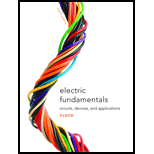
Concept explainers
The area of the plates of a capacitor is proportional to the capacitance.
Whether the statement is true or false.
Answer to Problem 1TFQ
True
Explanation of Solution
Given:
The given statement is
Capacitance value associated with any capacitor is proportional to the area of the plates of the capacitor.
Calculation:
A capacitor is a gadget that can store charge. It is a gadget that can store charge which neither a resistor nor an inductor can do. It restricts any difference in voltage in the circuit where it is associated and it obstructs the section of direct current through it. Basically, a capacitor comprises of two leading plates isolated by a protecting medium called a dielectric.
The value of capacitance can be calculated by the expression
Where,
C = Capacitance
A = Area
d = distance between the plates
It is clear from the above expression that the capacitance is directly proportional to the area of the plates.
Hence, the given statement is true.
Want to see more full solutions like this?
Chapter 9 Solutions
Electronics Fundamentals: Circuits, Devices & Applications
- Two capacitors having values of 80 F and 60 F are connected in series. What is the total capacitance?arrow_forwardThree capacitors having values of 2.2 F, 280 F, and 470 pF are connected in parallel. What is the total capacitance?arrow_forwardIf a capacitor produces 15 ampere on a 240-volt supply, which of the following is its microfarad rating? 166 microfarad 15 microfarad 200 microfarad 3450 microfaradarrow_forward
- A postage stamp mica capacitor has the following color marks starting at the upper left dot: yellow, violet, brown, green, no color, and blue. What are the capacitance value, tolerance, and voltage rating of this capacitor?arrow_forwardWhat is the minimum KVAR rating of each capacitor in Question 11? (Round off the value to the nearest KVAR.)arrow_forwardThis circuit is connected to a 1000-Hz line. The resistor has a voltage drop of 185 V. the inductor has a voltage drop of 740 V, and the capacitor has a voltage drop of 444 V. The circuit has an apparent power of 51.8 VA. ETITZVA51.8PFER185VIRRPEL740VILXLVARsLLEC444VICXCVARsCCarrow_forward
- What is the minimum AC voltage rating of each capacitor in Question 11?arrow_forwardYou find that a 25-F capacitor connected to 480 VAC is defective. The storeroom has no capacitors with a 480-VAC rating. However, you find two capacitors rated at 50 F and 370 VAC. Can these two capacitors be connected in such a manner that they can replace the defective capacitor? If yes, explain how they are connected and why the capacitors will not be damaged by the lower voltage rating. If no, explain why they cannot be used without damaging the capacitor.arrow_forwardThe circuit in Figure 24-2 is connected to a 120-V, 60-Hz line. The resistor has a resistance of 36 , the inductor has an inductive reactance of 40 , and the capacitor has a capacitive reactance of 50 . ET120VITZVAPFERIRR36PELILXL40VARsLLECICXC50VARsCCarrow_forward
- Three capacitors having capacitance values of 20F,40F, and 50F are connected in parallel to a 60 - Hz power line. An ammeter indicates a circuit current of 8.6 amperes. How much current is flowing through the 40F capacitor?arrow_forwardA capacitor uses air as a dielectric and has a capacitance of 3 F. A dielectric material is inserted between the plates without changing the spacing, and the capacitance becomes 15 F. What is the dielectric constant of this material?arrow_forwardWhat is the unit of measurement for the strength of a capacitor? microamp microtorque microfarad microwattarrow_forward
 Delmar's Standard Textbook Of ElectricityElectrical EngineeringISBN:9781337900348Author:Stephen L. HermanPublisher:Cengage Learning
Delmar's Standard Textbook Of ElectricityElectrical EngineeringISBN:9781337900348Author:Stephen L. HermanPublisher:Cengage Learning Electricity for Refrigeration, Heating, and Air C...Mechanical EngineeringISBN:9781337399128Author:Russell E. SmithPublisher:Cengage Learning
Electricity for Refrigeration, Heating, and Air C...Mechanical EngineeringISBN:9781337399128Author:Russell E. SmithPublisher:Cengage Learning

